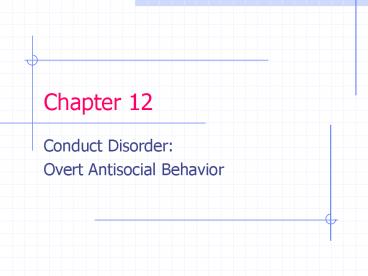Conduct Disorder: - PowerPoint PPT Presentation
1 / 33
Title:
Conduct Disorder:
Description:
Exhibits a persistent pattern of anti-social behavior that ... behavior is associated with serious psychopathology in the child, the family or both ... – PowerPoint PPT presentation
Number of Views:1059
Avg rating:3.0/5.0
Title: Conduct Disorder:
1
Chapter 12
- Conduct Disorder
- Overt Antisocial Behavior
2
Definition
- Exhibits a persistent pattern of anti-social
behavior that significantly impairs everyday
functioning at home or school or that leads
others to conclude that the youngster is
unmanageable. - Persistent pattern of behavior in which the
rights of others and age-appropriate social norms
are violated BULLIES!!!
3
Definition
- Isolated acts of physical aggression, destruction
of property, stealing, and fire-setting are also
cause for concern. - See table 12.1 on page 291
4
DSM-IV Criteria
- Aggression to people/animals
- Destruction of property
- Deceitfulness or theft
- Serious violations of rules
- Problems dont diminish with age as with most
children
5
Prevalence
- Under age 18
- Males-6-16
- Females-2-9
- Girls tend to exhibit fewer overt aggressive acts
- Prevalence is increasing
- Severity of disorder is perceived as increasing
6
Classification
- Onset before 10 years
- More severe impairment
- Poorer prognosis
- Adolescent onset
- Undersocialized More overt acts (see fig. 12.1
p. 294) - Socialized More covert acts
- Versatile Characteristics of both
7
Undersocialized
- More violent acts
- Hyperactive
- Impulsive
- Stubborn
- Demanding
- Argumentative
- Teasing
- Loud
8
Undersocialized
- Threatening
- Attacking others
- Cruelty
- Fighting
- Showing off
- Bragging
- Swearing
9
Undersocialized
- Blaming others
- Sassy
- Disobedient
- Poor peer relations
10
Socialized
- More covert acts
- Negativism
- Lying
- Destructiveness
- Stealing
- Fire-setting
- Gangs
11
Socialized
- Associating with bad companions
- Running away
- Truancy
- Substance abuse
12
Versatile
- Characteristics of both
- What would be an example of versatile behavior?
13
Aggression and Violence in Social Context
- Aggression as a multicultural issue
- Focus should be on problems of economic/community/
family difficulties - Aggression in the context of school
- BE PREPARED!!!
14
Factors
- Genetic and biological
- Social environment
- Aggression in family
- Rejection in various environments
- Academic failure
- Success in controlling others by aggression
15
Factors
- Modeling of aggression especially by high status
models - Practice of aggression (without consequences)
- Diminished reinforcement for appropriate
behavior-reinforcement for aggression
16
Factors
- Cognitive processes that justify acts
- Inappropriate punishment
- TV aggression
- Delinquent subcultures
17
Causal Factors
- Three major controlling influences
- Environmental factors
- The behavior itself
- Cognitive/affective (person)variables
18
Causal Factors
- General conclusions from Social Learning Research
P. 302-304 - Personal factors
- Family factors
- School factors
- Peer group/cultural factors
19
Prevention
- Consequences for aggression
- Reach non-aggressive responses
- Stop aggression early
- Restrict access to instruments of aggression
- Correct everyday conditions
- Offer more effective educational options
20
Prevention
- Recognize importance of instruction as a key tool
for prevention - What does this mean for teachers??
- Pre-correction plan p. 310
21
Assessment
- Multi-dimensional rating scales
- Pro-social skills assessment
- Comparison to peers/norms
- Assess behavior in social contexts
- Who else contributes
- Family concerns
- Environmental influences
- Functional analysis
22
Interventions
- Rules
- Praise
- Positive reinforcement
- Verbal feedback
- Stimulus change
- Contingency contracts
- Modeling plus reinforcing imitation
23
Interventions
- Shaping
- Social skills training
- Self-regulation training
- Timeout
- Response cost
- Proper use of punishment p. 306-307
24
Acting-out behavior cycle
- Calm
- Recognize triggering events
- Agitation Engage in alternative activities,
proximity control - Acceleration Avoid power struggle, crisis
intervention - Peak phase Get help!
- De-escalation Let them be
- Recovery Reinforce appropriateness
25
School-wide violence and School-wide discipline
- Set clear behavioral expectations
- Establish a positive school climate
- Monitor student behavior continuously
- Apply consistent consequences
- Provide collegial support
- Maintain clear communication
26
Chapter 13 Covert Behavior
- Stealing
- Lying
- Fire-setting
- Vandalism
- Truancy
27
Stealing
- Family resistance to therapy
- Lack of parental supervision and attachment
- Generalizations p. 321
28
Lying
- Little research
- Often used to escape punishment
- Often a steppingstone to other conduct problems
- Requires careful monitoring
29
Fire-setting
- Fires set by children account for ½ of all set
fires - More likely to occur in children who are around
adults who model behavior dealing with fire
30
Fire-setting
- More likely to set fires when
- Do not understand danger of fires
- Lack necessary social skills to obtain
gratification appropriately - Engage in other antisocial behaviors
- Motivated by anger and revenge
31
Fire-setting
- In preschoolers this behavior is associated with
serious psychopathology in the child, the family
or both - In school-age children
- History of school failure
- Multiple behavior problems
32
Vandalism
- Punitive response may heighten problem
- Often is the response to aversive environments
- Vague rules
- Punitive discipline
- Rigidly applied punishment
- Impersonal relations
- Poor curriculum match
- Little positive recognition
33
Truancy
- Relevant curriculum???































